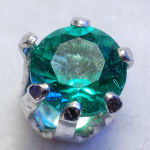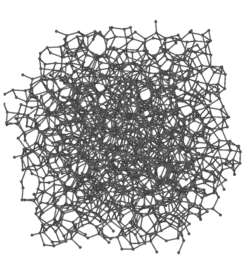Amorphous solid
An Amorphous solid is a solid with no defined shape or structure. This type of solid is the opposite of a crystalline solid, which forms geometric shapes in contrast. Because of the structure of amorphous solids, they have unique properties. They have no defined melting point, don not form geometric shapes when broken, and lack long range order. Amorphous solids form when a liquid is cooled too quickly to arrange into a pattern. Any material can form an amorphous solid if cooled quickly enough. Amorphous solids can form both naturally and with human help. Some molecules that commonly form amorphous solids are glass, sulfur, polymers, and carbon. Amorphous solids are valuable in everyday life. Glass is used in packaging, tableware, housing, buildings, interior design, furniture, appliances, electronics, medical technology, and much more. Various types of polymers are used in construction, packaging, electronics, transportation and more.
Chemical Properties
Amorphous solids are solids in which molecules are arranged randomly. This type of solid has distinct properties that set it apart from crystalline solids. Amorphous solids do not form geometric shapes and when they break, they form irregular shapes. Their melting points are not specific, but within a range of temperatures. Although amorphous solids do not have long range order, they do exhibit some short range order. [1]
Natural Occurrences


Amorphous solids can occur naturally and with human help. They form when a liquid cools too quickly for the molecules to arrange themselves in a pattern. [1] Amorphous solids that occur naturally are called mineraloids. An example of amorphous solids in nature are natural glasses (also known as lechatelierites). These are formed in large quantities when lava that contains a greater than average amount of silica is cooled rapidly by air during a volcanic eruption or by water in an underwater eruption. [2]
Synthesis
Although amorphous solids form naturally, they can be manipulated into this state by adding an additive that disrupts the molecules from arranging into a pattern. [1] There are various other techniques to coerce liquids into amorphous solids, such as melt spinning, sol gel synthesis, laser glazing, pyrolysis, and electrolysis. [3]
Melt spinning is used in the production of polymer fibers and metallic glass. The substance is melted then filtered. As it cools, it goes through a spinneret and twisted. The fibers can have different cross-sectional shapes (such as round, trilobal, pentagonal, octagonal, etc.) which are useful for different products. [4] In sol gel synthesis, molecules dissolved in an aqueous solution bond together in a disorganized fashion. Lasers can be used to create amorphous solids as well, such as in the laser glazing method, where strong lasers melt a material and the material surrounding it cools it quickly. [3]
Even crystalline solids can be transformed into amorphous solids by bombarding them with ions with a lot of kinetic energy. [3] If crystalline solids encounter alpha-particle radiation emitted by uranium or thorium, the radiation can sever bonds and disrupt the orderly structure. If this happens enough to a crystalline solid, it can become an amorphous solid. This type of amorphous solid is called a metamict mineral. [2]
Uses
One of the most common examples of amorphous solids is also one of the most useful materials in everyday life: glass. It is undeniably valuable because of its transparency, which result from its amorphous properties. Clear glass is used in packaging, tableware, housing, buildings, interior design, furniture, appliances, electronics, automotive, transport, medical technology, biotechnology, life science engineering, radiology, renewable energy, and much more. [5]
Polymers are other valuable amorphous solids. They make up a variety of inorganic substances, such as rubber, cellulose, plastic, and even organic materials like leather, wool, cotton, silk, and wood. [6] Plastic is one of the most widely used material in everyday life. It is used in construction, packaging, electronics, transportation, and much more. It is so useful in many products because it is flexible, durable, and lightweight. [7] Rubber is another popular polymer. It is known for its strength, durability, water resistance and heat resistance. It is utilized in playground equipment, shoes, mats, flooring, healthcare supplies, household supplies, balls, toys and of course, tires. [8]
Common Amorphous Substances
- Glass
- Sulfur
- Cotton Candy
- Mayonnaise
- Chocolate mousse
- Plastic
- Rubber
- Polymers
- Mud
- Carbon
Video
Additional information about the properties of amorphous solids.
References
- ↑ 1.0 1.1 1.2 Amorphous Solids Lumen. Web. Accessed 26 April, 2018. Unknown Author.
- ↑ 2.0 2.1 Amorphous Encyclopedia.com. Web. Accessed 26 April 2018. Unknown Author.
- ↑ 3.0 3.1 3.2 Mahan et al. Amorphous Solid Britannica. Web. Last edited 22 April 2016.
- ↑ Kiron, Mazharul Islam. Melt Spinning Process TextileLearner. Web. Accessed 26 April 2018.
- ↑ Glass Applications Glass Alliance Europe. Web. Accessed 26 April 2018. Unknown Author.
- ↑ Lower, Stephen. Polymers and Plastics Chem1. Web. Last edited 23 October 2017.
- ↑ Plastics Applications British Plastics Federation. Web. Accessed 26 April 2018. Unknown Author.
- ↑ . The Many Uses of Rubber Polymer Search. Web. Accessed 26 April 2018. Unknown Author.
| ||||||||||||||




